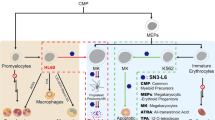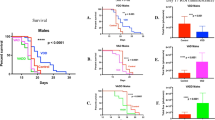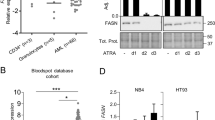Abstract
Human myeloid leukemia cell lines are induced to terminal differentiation into monocyte lineage by 1,25-dihydroxyvitamin D3 (1,25D3) or its analogs (deltanoids). However, translation of these findings to the clinic is limited by calcemic effects of deltanoids. Strategies to overcome this problem include combination of deltanoids with other compounds to induce differentiation at lower, noncalcemic, deltanoid concentrations. We previously showed that either carnosic acid, an antioxidant, or SB202190, a p38 MAPK inhibitor, increase the potency of 1,25D3 in the HL60 cell line. Here, we report that simultaneous addition of both these agents further increases differentiation potency of deltanoids in this cell line and in freshly obtained leukemic cells ex vivo. Activity of MAPK pathways showed that increased differentiation was associated with enhanced activity of JNK pathway in all responding cell subtypes. Our studies suggest that patients with CML or AML subtypes M2 and M4, but not M1, M3 or M4eo, are particularly suitable for this combination therapy. We conclude that the established cell line HL60 presents a good model for some, but not all, subtypes of myeloid leukemia, and that the JNK pathway plays an important role in monocytic differentiation of human leukemic cells ex vivo, as well as in vitro.
This is a preview of subscription content, access via your institution
Access options
Subscribe to this journal
Receive 12 print issues and online access
$259.00 per year
only $21.58 per issue
Buy this article
- Purchase on Springer Link
- Instant access to full article PDF
Prices may be subject to local taxes which are calculated during checkout




Similar content being viewed by others
References
Castaigne S, Chomienne C, Daniel MT, Ballerini P, Berger R, Fenaux P et al. All-trans retinoic acid as a differentiation therapy for acute promyelocytic leukemia. I. Clinical results. Blood 1990; 76: 1704–1709.
Huang ME, Ye YC, Chen SR, Chai JR, Lu JX, Zhoa L et al. Use of all-trans retinoic acid in the treatment of acute promyelocytic leukemia. Blood 1988; 72: 567–572.
Koeffler HP . Induction of differentiation of human acute myelogenous leukemia cells: therapeutic implications. Blood 1983; 62: 709–721.
Abe E, Miyaura C, Sakagami H, Takeda M, Konno K, Yamazaki T et al. Differentiation of mouse myeloid leukemia cells induced by 1a, 25-dihydroxyvitamin D3 . Proc Natl Acad Sci USA 1981; 78: 4990–4995.
Studzinski GP, McLane JA, Uskokovic MR . Signaling pathways for vitamin D-induced differentiation: implications for therapy of proliferative and neoplastic diseases. Crit Rev Eukaryot Gene Expr 1993; 3: 279–312.
Honma Y, Hozumi M, Abe E, Konno K, Fukushima M, Hata S et al. 1,25-dihydroxyvitamin D3 and 1 alpha-hydroxyvitamin D3 prolongs survival time of mice inoculated with myeloid leukemia cells. Proc Natl Acad Sci USA 1983; 80: 201–204.
Zhou JY, Norman AW, Chen DL, Sun GW, Uskokovic M, Koeffler HP . 1,25 (OH)2-16ene-23ene-vitamin D3 prolongs survival time of leukemic mice. Proc Natl Acad Sci USA 1990; 87: 3929–3932.
Koeffler HP, Hirji K, Itri L . 1,25-dihydroxyvitamin D3: in vivo and in vitro effects on human preleukemic and leukemic cells. Cancer Treat Rep 1985; 69: 1399–1407.
Kelsey SM, Newland AC, Cunningham J, Makin HLJ, Coldwell RD, Mills MJ et al. Sustained hematological response to high-dose oral alfacalcidol in patients with myelodysplastic syndromes. Lancet 1992; 340: 316–317.
Pakkala S, de Vos S, Elstner E, Rude RK, Uskokovic M, Binderup L et al. Vitamin D3 analogues: effects on leukemic clonal growth and differentiation, and on serum calcium levels. Leuk Res 1995; 19: 65–72.
Norman AW, Zhou JY, Henry HL, Uskokovic MR, Koeffler HP . Structure-function studies on analogues of 1α, 25-dihydroxyvitamin D3: differential effects on leukemic cell growth, differentiation, and intestinal calcium absorption. Cancer Res 1990; 50: 6857–6864.
Quesada JM, Lopez-LLuch G, Buron MI, Alcain FJ, Borrego F, Velde JP et al. Ascorbate increases the 1,25 dihydroxyvitamin D3-induced monocytic differentiation of HL-60 cells. Calcif Tissue Int 1996; 59: 277–282.
Sokoloski JA, Hodnick WF, Mayne ST, Cinquina C, Kim CS, Sartorelli AC . Induction of the differentiation of HL-60 promyelocytic leukemia cells by vitamin E and other antioxidants in combination with low levels of vitamin D3: possible relationship to NF-kappaB. Leukemia 1997; 11: 1546–1553.
Wang Q, Salman H, Danilenko M, Studzinski GP . Cooperation between antioxidants and 1,25-dihydroxyvitamin D(3) in induction of leukemia HL60 cell differentiation through the JNK/AP-1/Egr-1 pathway. J Cell Physiol 2005; 764–774.
Wang X, Studzinski GP . Inhibition of p38 MAP kinase activity up-regulates multiple MAP kinase pathways and potentiates 1,25-dihydroxyvitamin D3-induced differentiation of human leukemia HL60 cells. Exp Cell Res 2000; 258: 425–437.
Gallagher R, Collins S, Trujillo J, McCredie K, Ahearn M, Tsai S et al. Characterization of the continuous, differentiating myeloid cell line (HL60) from a patient with acute promyelocytic leukemia. Blood 1979; 54: 713–733.
Ji Y, Kutner A, Verstuyf A, Verlinden L, Studzinski GP . Derivatives of vitamins D2 and D3 activate three MAPK pathways and upregulate pRb expression in differentiating HL60 cells. Cell Cycle 2002; 1: 410–415.
Wang X, Studzinski GP . Activation of extracellular signal-regulated kinases (ERKs) defines the first phase of 1,25-dihydroxyvitamin D3-induced differentiation of HL60 cells. J Cell Biochem 2001; 80: 471–482.
Wang Q, Wang X, Studzinski GP . Jun N-terminal kinase pathway enhances signaling of monocytic differentiation of human leukemia cells induced by 1,25-dihydroxyvitamin D3 . J Cell Biochem 2003; 89: 1087–1101.
Chen F, Wang Q, Wang X, Studzinski GP . Up-regulation of Egr-1 by 1,25-dihydroxyvitamin D3 contributes to increased expression of p35 activator of cyclin-dependent kinase 5 and consequent onset of the terminal phase of HL60 cell differentiation. Cancer Res 2004; 64: 5425–5433.
Chen G, Hitomi M, Han J, Stacey DW . The p38 pathway provides negative feedback for Ras proliferative signaling. J Biol Chem 2000; 275: 38973–38980.
Acknowledgements
This work was supported by the NIH Grant RO1-CA44722-15 from the National Cancer Institute. We thank Dr Robert Gorman for a sample of blood from a patient with CML, and Jing Zhang for valuable help with the project.
Author information
Authors and Affiliations
Corresponding author
Rights and permissions
About this article
Cite this article
Wang, Q., Harrison, J., Uskokovic, M. et al. Translational study of vitamin D differentiation therapy of myeloid leukemia: effects of the combination with a p38 MAPK inhibitor and an antioxidant. Leukemia 19, 1812–1817 (2005). https://doi.org/10.1038/sj.leu.2403916
Received:
Accepted:
Published:
Issue Date:
DOI: https://doi.org/10.1038/sj.leu.2403916
Keywords
This article is cited by
-
The microRNA-26a target E2F7 sustains cell proliferation and inhibits monocytic differentiation of acute myeloid leukemia cells
Cell Death & Disease (2012)
-
Synergism between carnosic acid and arsenic trioxide on induction of acute myeloid leukemia cell apoptosis is associated with modulation of PTEN/Akt signaling pathway
Chinese Journal of Integrative Medicine (2012)
-
Signal transduction pathways that contribute to myeloid differentiation
Leukemia (2007)



